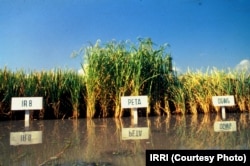Back in 1966, Nekkanti Subha Rao, a farmer in India’s southern state of Andhra Pradesh planted a semi-dwarf rice variety developed by the International Rice Research Institute on 1,000 hectares of land.
Crossbred from a tall variety in Indonesia and a dwarf variety in China, IR8 was the world’s first high yielding rice and is credited with having prevented famines and sparking the Green Revolution in rice in Asia.
As India and the International Rice Research Institute in the Philippines celebrate the 50th anniversary of what came to be known as the Miracle Rice, farmer Rao, now 80 years old, recalls the wonder of the moment when he harvested an astonishing 7.5 tons per hectare. “Never before,” he said. “Every farmer feeling very, very, very happy, happy. 100 percent success.”
In the 1960s and 1970s, when India and several Asian countries grappled with food shortages, IR8 and varieties that followed helped triple rice output in Asia and fended off the specter of widespread hunger.
“It transformed agriculture, which averted the perennial food crises that happened in those years, those decades. It saved millions of lives,” said Dr. Nafees Meah, IRRI’s regional representative for South Asia.
After India, IR8 went on to be planted across a host of Asian countries, such as the Philippines, Vietnam and Cambodia, where rice is the staple food for most people.
In all these countries, say agriculture scientists, it did not just boost yields. The shorter length of the crop made it sturdier and less prone to collapsing before harvest time. And as it took less time to mature compared to traditional rice strains, it allowed farmers to cultivate more than one crop on the same land.
“It reduced the duration quite significantly and it continues to do so. Vietnam right now, in many parts of Mekong Delta where water is there, they grow three crops a year, primarily because of shorter duration varieties,” said Samarendu Mohanty, Head of Social Sciences at IRRI in Philippines.
In about two decades, the IR8 made way to a host of other high yield varieties, but it is the parental strain for many of these. Recalling its phenomenal contribution, Mohanty said that in India alone, it is estimated to have contributed $1.3 billion annually to the rice sector.
But ensuring food security is no longer the only challenge for Asia - a continent that is far more affluent than it was 50 years ago. At the same time, malnourishment continues to haunt millions of poor in the region, especially in South Asia. And everywhere, farmers are battling climate change.
“Developing new varieties that are higher yielding and more nutritious, but ones that have less of an environmental footprint, ones that require less water, fertilizer, pesticide and ones that actually have reduced greenhouse gas emissions,” said Rod Wing, an American scientist at IRRI in Manila as he outlines the challenges of the 21st century.
In recent years, new varieties that are more resistant to droughts and floods are showing promising results in east India and Bangladesh, a delta country where flash floods used to submerge or wash away crops.
“With these new varieties, we have got a real opportunity,” Meah said. “It has been adopted by millions of farmers, so they see the benefits of it. And it’s a real improvement for their livelihoods as well.”
To improve nutritional levels, a genetically engineered strain has been developed to address Vitamin A deficiency that kills many under the age of five. On the other end of the spectrum, as Asia copes with what are sometimes called diseases of affluence and witnesses an explosion in the incidence of diabetes, scientists are developing varieties with low glycemic index, which release energy slowly.
But the core challenge of productivity that IR8 sparked has still not gone away. “The big question is how do we solve the 10 billion people question? That is, how are we going to feed three more billion people on the planet by 2050? It is a huge, daunting task,” said Wing at IRRI, pointing out that rice is the staple diet of more than half the world.
And while farmers are harvesting higher and higher yields, they continue to battle other problems. “Cost of cultivation very, very high now. Labor cost is high,” rued farmer Subha Rao from his home in Andhra Pradesh.








